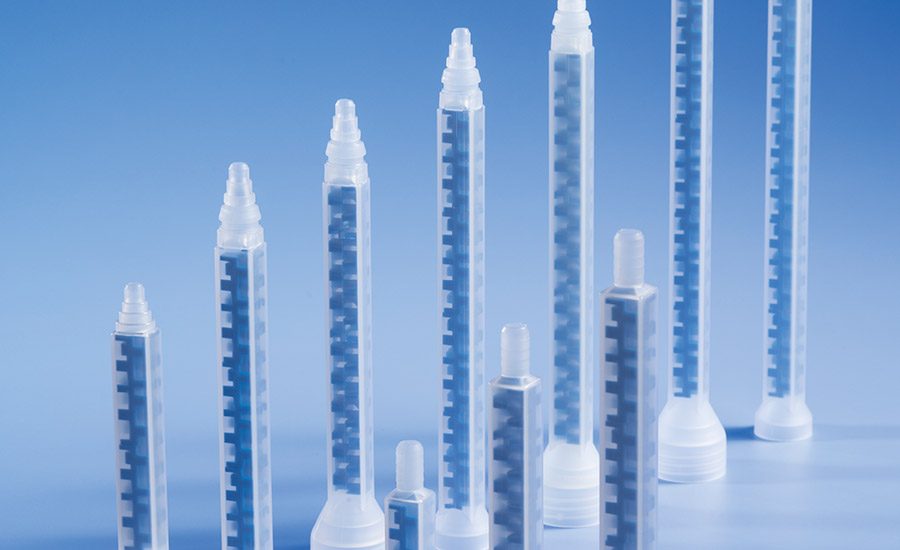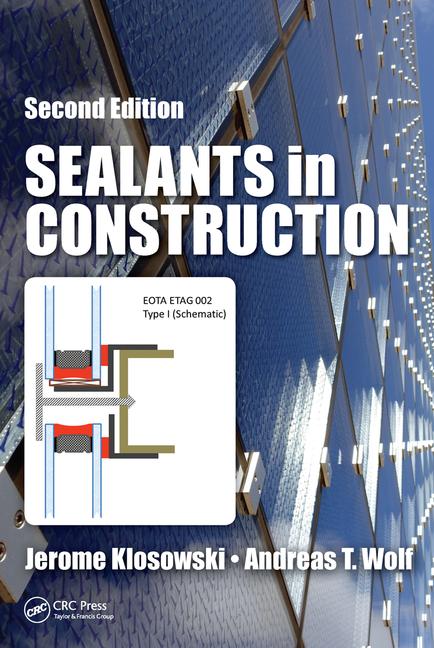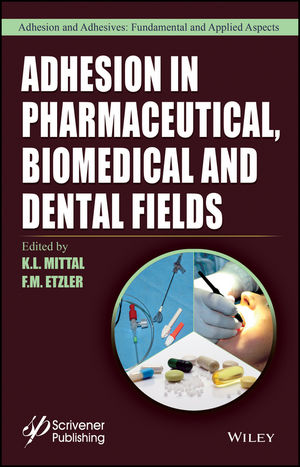Mixing Two-Component Fluids in Exacting Proportions
A new static mixing method can completely mix 2K adhesives and improve material performance when compared to traditional techniques.




Construction and automotive repair often require controlled blends of adhesives and sealants. Reliable and efficient applications can depend on precise and repeatable placement of epoxies and other two-component (2K) adhesives and sealants for such tasks as concrete anchoring, crack injection, foam insulation, seam sealers, bumper repair, windshield installation, and sound deadening. Before 2K adhesives can be applied, however, they must be properly mixed; this mixing process cannot be taken for granted. Studies have shown that poorly mixed 2K adhesives can suffer a loss in adhesion strength, resulting in compromised long-term durability and reliability. Similarly, 2K sealants are often processed in a similar manner and the mixing process is critical for optimum results.
Fortunately, a significant advance was made recently in the state of fluid mixing dynamics. A patented 2K fluid mixing approach was developed by combining knowledge of fluid dynamics with computer-aided modeling and analysis. The new static mixing method provides complete mixing of 2K adhesives in a shorter length than earlier 2K mixer techniques. It yields excellent flow rates with thorough mixing of the two fluid components and 30% less retained fluid volume compared to previous disposable mixers.
Applying Adhesives with Static Mixers
Static mixers work with 2K cartridges and dispensers to apply a mixed adhesive or sealant in a precise ratio on demand where needed. Ideally, a 2K mixer will blend the two fluid components into one homogeneous fluid in the shortest distance possible―and with the least material waste. A short mixing time implies a mechanically short structure to perform the mixing of the fluid components, and the new 2K mixing method is based on an innovative flow path that achieves complete mixing of two fluid components, including adhesives and sealants, in a relatively short fluid path length.
This novel disposable static mixer is an improvement on existing square geometry when compared to earlier 2K fluid mixers with spiral geometries. It is designed to attach to most large-volume (≥ 200 mL) commercial 2K dispensing cartridges and systems and can handle many different fluids, including sealants and adhesives, for a range of industries, such as automotive, aerospace, construction, electronics, and maintenance, repair, and operations (MRO). The short length means that effective mixing can be achieved while at the same time providing the capability to position the fluid mixer/dispenser closer to the work surface.
The Role of Research
The new fluid mixing solution was developed through an understanding of fluid dynamics. The mixing of two fluids is complex and tends to be nonlinear in nature, as the aggregate viscosities of the fluids change during the mixing process and the viscosity of the final solution changes as it begins its curing process. Nonlinear behavior occurs at the interfaces of the two fluids but, by means of techniques such as fluid stretching, it is possible to analyze and model these nonlinear dynamics of the two mixing fluids.
Fluid mixing can occur in different ways, such as by random mixing, chaotic mixing and laminar mixing. In random mixing, random fluid structures are produced by the instabilities of the two moving fluids; in chaotic mixing, laminar flows can produce complex distributions of the two fluid components. The fluid motions change as functions of space and time, with inhomogeneous mixing effects such as fluid stretching occurring as fluids flow at different rates as a function of a given change in time, Dt. Because stretching is inhomogeneous, the challenge in developing an efficient mixing structure is to achieve a homogeneous solution of the two fluid components in the shortest mixing distance and time possible. Mathematical analysis allows the use of probability density functions to predict the mixing rates expected from different mixing geometries for given viscosities of fluid components, and a great deal of research has been performed on fluid mixing in this area, such as with models for the mixing of water in oil emulsions to better understand the fluid dynamics of 2K component fluids. The new mixer design approach uses laminar mixing because this method requires less energy to achieve a given mix quality.
Proprietary software also contributed to the development of the new 2K square disposable static mixer. The software, which required two years to develop, was used to analyze a large number of different mixing geometries for their resulting flow patterns when mixing two fluid components of similar viscosities. The computer analysis consisted of selecting an input pattern, such as D-shaped inlets, and then studying the flow patterns and flow rates produced by different mixing geometries. Hundreds of different fluid path angles and openings were simulated and analyzed, and then fabricated into prototype mixing structures to test actual flow rates and mixing effectiveness.
When evaluated by a customer needing to dispense a 2K adhesive with a battery-powered dispenser system, the new static mixer design yielded impressive results. The customer’s goals were to achieve improved flow rates in order to apply more adhesive in less time with less applied force. From an actual application, it was learned that the effectiveness of the new mixer design resulted in considerably shorter cure time for the adhesive. The new mixing geometry achieved a cure time of 90 min, vs. two hours for a conventional static mixer.
The new mixing approach was incorporated into a square mixer about one-third the length of a spiral mixer currently being used for this application. In comparison, the new mixer resulted in much less retained fluid within the square mixer compared to the longer, spiral mixer.
The new mixing geometry has been implemented in a line of commercial mixer products.* These mixers are produced with different numbers of wedge elements, depending upon desired mixer length and volume capacity, from nine to 41 mixing elements and housing lengths from 2.9-8.1 in. This choice of lengths provides some working flexibility, in being closer to the work surface with shorter mixers and having greater mixing efficacy with longer mixers. The new mixers are about 20% shorter than comparable square mixers currently on the market.
The retained volume of material for these new mixers is extremely low, and dependent upon mixer length, with only 1.6-10 mL retained fluid volume for the longest mixer. The mixer is designed with barbed or stepped outlets and bell-shaped or integral nut inlets for use with many different dispensing systems. It is well-suited for use with all industry-standard dispensers (manual, pneumatic or battery powered) for ease of fluid application in hard-to-reach surfaces. In addition, it provides the mixing quality demanded of various critical applications, including in medical product assembly. It is suitable for mixing such 2K fluids as epoxies, urethanes, silicones, and hybrids, and can be used for applying adhesives, seals, bonding, undercoats, and gaskets.
The impact of such an advance in two-component fluid mixing should not be overlooked. The improvements in curing time and the reduced waste of adhesive or sealing materials can mean higher yields and reduced costs in high-volume applications. In addition, the improved homogenous adhesives produced by such a mixer will contribute to the improved quality of assembled products, in addition to the improved quality of many other applications requiring mixing of 2K fluids. ASI
For more information, phone (800) 556-3484 or (401) 431-7000, fax (401) 431-7079, or visit http://nordsonefd.com.
Looking for a reprint of this article?
From high-res PDFs to custom plaques, order your copy today!










